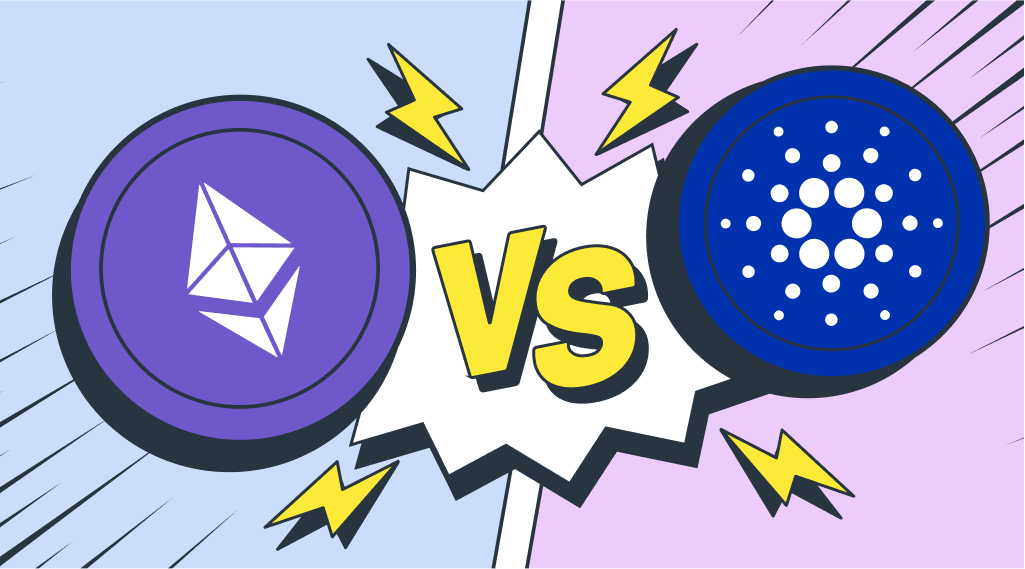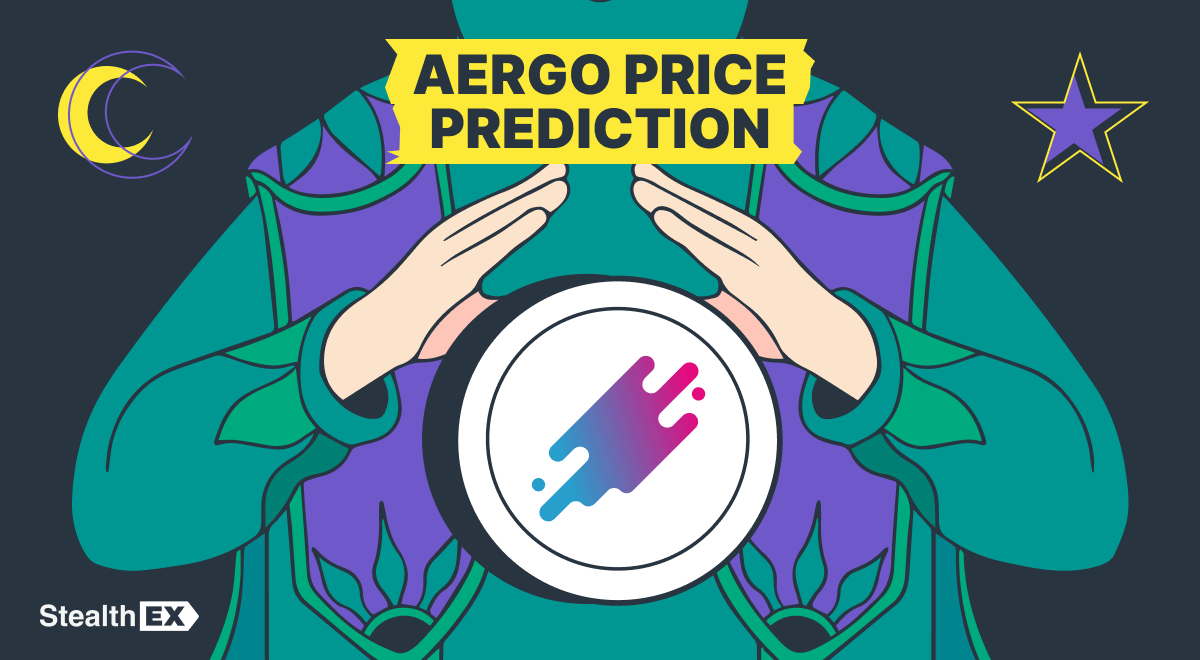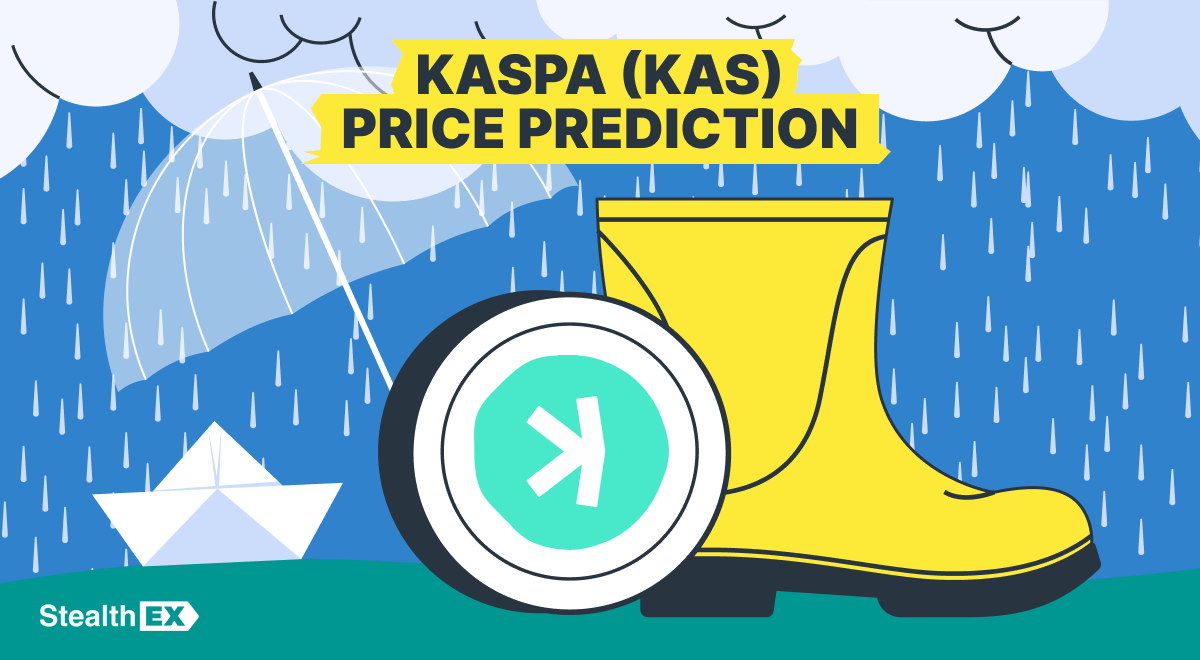Cardano vs Ethereum — Which Is Better? ADA and ETH Comparison

When exploring the crypto sector, two big names pop up: Cardano (ADA) and Ethereum (ETH). Both aim to power the future through decentralized tech, but they do it uniquely. This easy-to-follow guide will compare these two giants, highlighting their similarities and differences. Let’s dive into the journey of Cardano vs Ethereum and see what they each bring to the table!

Article contents
- 1 What Is Ethereum (ETH)?
- 2 What Is Cardano (ADA)?
- 3 Cardano vs Ethereum – Key Differences Between ADA and ETH
- 4 Cardano vs Ethereum – Key Similarities Between ADA and ETH
- 5 Cardano vs Ethereum – Comparison Table
- 6 Summary
- 7 FAQ – Cardano vs Ethereum
- 7.1 What Are the Core Differences Between Cardano and Ethereum?
- 7.2 How Are Cardano and Ethereum Similar?
- 7.3 Which Platform Is More Energy-Efficient?
- 7.4 Which Blockchain Has a Larger Developer Community?
- 7.5 How Do Smart Contract Capabilities Compare Between ADA and ETH?
- 7.6 Are Cardano and Ethereum Considered Cryptocurrencies?
- 7.7 How Do ADA and ETH Address Scalability and Interoperability?
- 7.8 Can I Create Decentralized Applications (DApps) on Both Platforms?
- 7.9 Which Platform Is Better for My Investment, Cardano or Ethereum?
- 7.10 How Do ADA and ETH Plan to Evolve in the Future?
What Is Ethereum (ETH)?
Ethereum is like a giant, global computer that anyone can use. It’s not controlled by one person or company but by many people worldwide. Imagine you have a special kind of money called “Ether”, which you can use to ask this big computer to do things for you, like send messages or keep safe notes.
People build “apps” on Ethereum that can do lots of different things, like create new kinds of money (tokens) or let people prove they own something (like a concert ticket) without needing a middleman like a bank or a ticket company.
These apps are secure and can’t be easily cheated because they use special math (cryptography) and many computers check the work. So, Ethereum is a shared computer that helps people make agreements and do business in a new and trustful way.
What Is Cardano (ADA)?
Cardano is a digital platform where people can send and receive digital money called “ADA”. Think of it like a huge, worldwide computer system that any single person or company doesn’t own.
What makes Cardano special is its strong focus on being secure and balanced, using science and peer-reviewed research to build its technology. It allows people to create smart contracts and build applications, like games or social media, without needing a middle person like a bank or app store.
Cardano is designed to be environmentally friendly, using less energy than Ethereum. It also aims to be fair and accessible to people worldwide, even in places where it’s hard to use regular money systems. So, Cardano is like a big, eco-friendly computer system that helps people use digital money, make deals, and create new applications securely.
Cardano vs Ethereum – Key Differences Between ADA and ETH
Cardano (ADA) and Ethereum (ETH) – both platforms have carved out significant niches in the crypto space yet diverge in their philosophies, technologies, and ultimate goals. Let’s delve into the key differences between these two blockchain giants.
Philosophical and Developmental Approach
Cardano: Often dubbed the “Ethereum of Japan,” Cardano adopts a methodical, peer-reviewed approach to development. It emphasizes rigorous academic research and ensures that all protocols undergo thorough scrutiny before implementation. This meticulousness aims to foster a robust and secure platform.
Ethereum: Ethereum, on the other hand, adheres to a more agile and experimental development model. It often implements changes and adjusts based on real-world experiences and feedback, allowing rapid innovation and evolution.
Consensus Mechanism:
Cardano: Utilizes a proof-of-stake (PoS) consensus mechanism known as Ouroboros. This energy-efficient system is designed to provide a more scalable and environmentally sustainable blockchain.
Ethereum: Ethereum operates on proof-of-stake (PoS) as well. The network made the transition from Proof-of-Work to enhance scalability and energy efficiency.
Smart Contract and DApp Development:
Cardano: It employs Plutus, a smart contract development platform that uses Haskell-based scripting language. This offers a higher assurance code and facilitates the creation of secure and robust smart contracts.
Ethereum: Ethereum uses Solidity for smart contract development, which has become the industry standard. Its maturity and widespread adoption have resulted in a rich ecosystem of tools and a large developer community.
Scalability and Interoperability
Cardano: It strongly emphasizes interoperability and aims to create a blockchain that can communicate and interact with other blockchains, fostering a more interconnected crypto space.
Ethereum: While Ethereum has faced challenges with scalability, Eth2 upgrade and the introduction of sharding and layer 2 solutions like rollups aim to boost its transaction throughput significantly.
Adoption and Ecosystem:
Cardano: While it has a robust technology and a growing community, Cardano is still in the early stages of its adoption journey, especially in decentralized finance (DeFi) and DApps.
Ethereum: Ethereum boasts a vast and mature ecosystem, being the first mover in the space. It is home to many DApps, tokens, and the DeFi sector.
While Ethereum and Cardano seek to leverage blockchain technology to create decentralized ecosystems, they embody different approaches and solutions to achieve their goals. Ethereum thrives on its first-mover advantage and rich developer ecosystem, while Cardano distinguishes itself with a research-driven approach and a strong focus on sustainability and interoperability.
Cardano vs Ethereum – Key Similarities Between ADA and ETH
Despite notable differences between ETH and ADA, it’s crucial to acknowledge that these blockchains share several commonalities. Let’s explore some of the key Ethereum and Cardano similarities.
Smart Contract Functionality – Both Cardano and Ethereum provide a platform for developing smart contracts. This functionality enables decentralized applications (DApps) creation and facilitates automated, trustless transactions within their respective ecosystems.
Decentralized Nature – The foundational principle of decentralization is deeply embedded in both platforms. Cardano and Ethereum operate on decentralized, distributed ledger technology, ensuring no single entity has overarching control over the entire network. This decentralization enhances security and promotes transparency across both blockchains.
Focus on Decentralized Finance (DeFi) – Both platforms strongly emphasize fostering the DeFi ecosystem. Cardano and Ethereum provide the technological infrastructure to develop DeFi applications, aiming to democratize finance and create an open and accessible financial system.
Utility Tokens – Both blockchains have native cryptocurrencies utilized for various purposes within their respective ecosystems. ETH is used for transaction fees and computational services on the Ethereum network, while ADA is used for stake delegation and voting for the protocol’s development in the Cardano network.
Governance and Future Development – Cardano and Ethereum have mechanisms for community involvement in governance. They allow their communities to participate in the decision-making process, ensuring that both platforms’ development and future direction align with their users’ needs and interests.
Academic and Community Engagement – Both platforms are backed by strong academic research and vibrant communities. Ethereum and Cardano benefit from active community engagement and contributions, which drive innovation, development, and adoption across both ecosystems.
Global Impact and Adoption – Cardano and Ethereum aspire to create a global impact by providing decentralized solutions to real-world problems. They aim to enhance accessibility to financial services, create decentralized identity solutions, and provide platforms for building decentralized applications that can be adopted across various industries.
While Cardano and Ethereum have unique attributes and challenges, they also share a common vision of leveraging blockchain technology to create more open, decentralized, and accessible financial and social systems. Both have played pivotal roles in advancing the blockchain industry and will likely continue to be significant contributors to the evolution of decentralized technologies and platforms.
Cardano vs Ethereum – Comparison Table
| Feature | Cardano (ADA) | Ethereum (ETH) |
| Development Approach | Research-driven, peer-reviewed methodology | Agile, experimental development model |
| Consensus Mechanism | Ouroboros (Proof-of-Stake) | Proof-of-Stake (Eth2) |
| Smart Contract Language | Plutus (Haskell-based) | Solidity |
| Energy Efficiency | Generally more energy-efficient | Trying to improve with upgrades |
| Developer Community | Growing, with a focus on research and academia | Large, established, and widely adopted |
| DeFi Ecosystem | Developing and expanding | Mature and highly developed |
| Native Cryptocurrency | ADA | ETH |
| Governance | On-chain governance with community participation | On-chain governance |
| Interoperability | High emphasis, with mechanisms like sidechains | Developing, with various bridging solutions |
| Scalability Solutions | Designed for scalability through its PoS mechanism | Implementing sharding and Layer 2 solutions |
| Main Use Cases | Smart contracts, DeFi, identity solutions | Smart contracts, DeFi, NFTs, decentralized applications |
| Adoption Stage | Still in the growth phase, especially in DeFi | Widely adopted, with a large user base |
Summary
Cardano and Ethereum are two big names in crypto space. They both are quite unique but also have some similarities. They use different methods and technologies to run, but both are super focused on keeping things decentralized and boosting the world of DeFi (decentralized finance). Even with their own sets of challenges and strengths, they both play a big role in how blockchain technology and decentralized systems are growing and changing today.”
FAQ – Cardano vs Ethereum
What Are the Core Differences Between Cardano and Ethereum?
Cardano and Ethereum differ mainly in their development approach, consensus mechanisms, and smart contract platforms.
How Are Cardano and Ethereum Similar?
Both platforms share a commitment to decentralization, providing a foundation for developing smart contracts and decentralized applications (DApps).
Which Platform Is More Energy-Efficient?
Cardano is generally considered more energy-efficient due to its proof-of-stake (PoS) consensus mechanism, Ouroboros.
Which Blockchain Has a Larger Developer Community?
Ethereum has a larger and more established developer community, given its first-mover advantage in the smart contract space.
How Do Smart Contract Capabilities Compare Between ADA and ETH?
Ethereum, using Solidity, has a mature and widely-adopted smart contract platform, while Cardano, using Plutus (a Haskell-based language), emphasizes high-assurance coding and security in smart contract development.
Are Cardano and Ethereum Considered Cryptocurrencies?
ADA (Cardano) and ETH (Ethereum) are cryptocurrencies utilized within their respective blockchains for various purposes like transaction fees, staking, and governance. They can also be traded on various cryptocurrency exchanges.
How Do ADA and ETH Address Scalability and Interoperability?
Cardano places a strong emphasis on interoperability and has implemented mechanisms like sidechains to communicate with other blockchains. Ethereum addresses scalability through upgrades, introducing sharding and layer 2 solutions like rollups.
Can I Create Decentralized Applications (DApps) on Both Platforms?
Yes, both Cardano and Ethereum provide platforms for developing decentralized applications (DApps), enabling developers to build various applications on their blockchains.
Which Platform Is Better for My Investment, Cardano or Ethereum?
Investment decisions should be based on thorough research and personal financial situations, as both Cardano and Ethereum have their unique features, challenges, and future prospects.
How Do ADA and ETH Plan to Evolve in the Future?
Both Cardano and Ethereum have robust roadmaps for future development, with Cardano focusing on sustainability and interoperability, and Ethereum working towards increased scalability and energy efficiency.
Follow us on Medium, Twitter, Telegram, YouTube, and Publish0x to stay updated about the latest news on StealthEX.io and the rest of the crypto world.
This article is not supposed to provide financial advice. Digital assets are risky. Be sure to do your own research and consult your financial advisor before investing.
ADA Cardano Cardano ADA ETH EthereumRecent Articles on Cryptocurrency
 Aergo Price Prediction: Can AERGO Coin Reach $100?
Aergo Price Prediction: Can AERGO Coin Reach $100?  Kaspa Price Prediction: Can KAS Coin Reach $1?
Kaspa Price Prediction: Can KAS Coin Reach $1? 